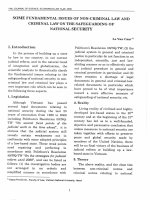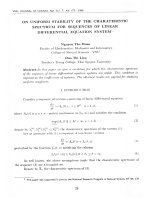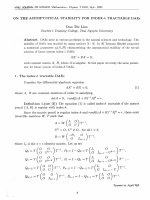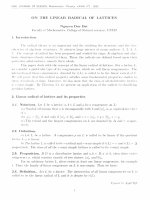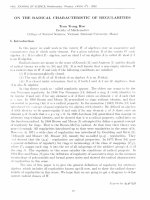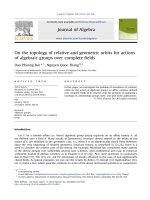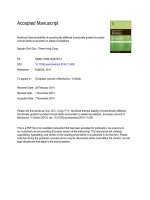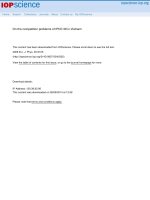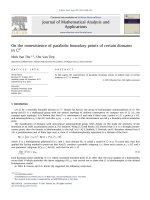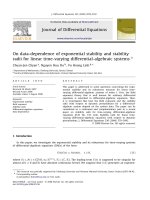DSpace at VNU: On uniform stability of the characteristic spectrum for sequences of linear differential equation system
Bạn đang xem bản rút gọn của tài liệu. Xem và tải ngay bản đầy đủ của tài liệu tại đây (3.14 MB, 8 trang )
VNU
J O U R N A L OF SCIEN C E. N a t . S c i . . . \
XV. n‘^5 - 1999
ON U N IF O R M STA BILITY OF TH E C H A R A T E R IS T IC
SP E C T R U M FO R SEQ U EN C ES OF L IN E A R
D IF FE R E N T IA L EQ U ATIO N S Y S T E M ’
N guyen T he H oan
Facility o f Mỉitheiiìatic^, Mechanics and InibriuHtics
College of Natiiial Scicjices - V N Ư
D a o T h i L ie n
TeHchei \s Trying Coilege. Thai N guy en U n i v e r s it y
A b s t r a c t: / / ? t/u.s paper we gwe a covdition for which the charateristic spectrum
of tÃc sequence of l i n t a r drjfereĩittaỉ equation systeTUS are stable .This condition IS
imposed 071 the coeffi.cemts of sys tems . The obtained results are applied f o r studying
un tfon n roìighĩiess.
I.
INTRODUCTION
C o n s i d e r a s e q i i e i i c e o f s y s t f ' i n s f o n s i s t i i i g OÍ l i n e a r c l i f f e r e i i t i a l e q u a t i o n
T e n '\
^ = .4 „ ( n .T ,
n =
(1)
fit
where An{f )
a
X
- m atrix contimious 01Ì [^O'Oo) and satisfies th e condition
^
sup
<
C X ),
'// — 1, 2, • • •
(2)
t>fa
denote by
the chaiatoristic spectrum of th e system (1).
Let MS as s o c ia t e w i t h (1) a s c q u e u r e of non-liiu'ar syyteiiis
^
= A „(/).r + /„ (/,.'■ )
(if
p ertu rb ed by the function ỷ n ự - x ) satisfying the relation
| / n ( ^ - r ) l | < <^».l|-i'||.0 < Ố,. < Ỗ < CO.
(4)
As well known, Ishe above assumptions imply th a t the charateristic spectrum s of
the sequence (3) are a bounded set.
Denote by A„ the charateristic spectrum of (3).
* This paper was supported in part by the National Research Program in N atural Scieces, K T 04, 137
28
O n u n i f o r m s t a b i l i t y o f the c h a r a t e r i s t i c spectr^um f o r , . .
D efinition.
29
T h e c h a r i i t e n s t i c s p c c tr u u i o f (1) is'saici to i>e iiiiifonuiy ìỉ ppcỉ-stỉihỉe if for
Huy g i v e n e > i) t h e r e e x i s t s Ò = ố{ f ) Sììch t h a t the H s sỉ uii ptỉ un (4) i m p l i e s
for all // € A „.
If the assiiniption (4) implies
then the chaiati'iistic sp(‘ctruni of (1) is said to be uniformly lower-stahlo.
If both the inoqualitios (5)-(6)hold. thoỉỉ tlif* charateristic spectrum of (1) is said to
be uniformly stable.
Tho notion of uniforin staỉ)ility of a charateristic spectrum for the sequence of
differential equation syst(niis is used in tho stu d y of uniform roughness of this sequence
and, in turn, the Iinifonii loughiioss of the sequence of dirft'rential equation systems is used
in estiination of Iiunxber of stable periodic solutions of the differential systems [1.
II.
SPECIAL CASE /„(/,.r) -
First of all. wo roiisiiler tlii‘ special case when*
is linear in x,that is:
fn{t.-r) 'I'hen th(' system (3) is of tilt' fonn
tỉ-i'
ih'iiuti \>\ \ \
-
, aÍ,
.4,,(/)./■ + /? , ( 0 ./ - ,
^ < Aj
// -
|| ữ „ (/) |ị <
the (. li ai nt t 1i^it ii
< (S V / > / o
(7)
11liiii of (T).
A]>plyiiig P fM o n ’s tiansfoiin ation
■r^U„{t)y,
(8)
where ư„{t ) is an orthogonal m atrix, tlu' system (1) is reduced to the triangular one
§
wliere Pn{t) =
{f ) A„{t ) Un{t ) -
= p»(')!/-
(9)
It is easy to verify th a t
\\Pn{f)\\ < M l , n =
by the traiisfoniiation (8), the system (7) becomes
dy
(if
where Qn{t ) Pn{t).
= P n [ f ) y + Qn{f ) y,
(10)
^{f ) Bn{t ) UnỰ) - Denote by P u \ t ) , p \ 2 \ f ),P 22 Ự) elements of the m atrix
N g u y e n The Hoan, D a o T h i Lien
3()
w<‘ rewrite the syst('iii (10) a.s
—
(h
{^ )// + Q i i ( n fl ■
( 1 1 )
w h o IP
K(t) =
V
0
Q „ (0 = Q n(0 +
Obviously, if
<
B „ ( f)
Ò:
io
= 1,2,... \vr liavc iic ? „{/)l| <
n
From tlu' rolatioii |1P„(0|| < Mị- 11= 1 .2 ,...
/— —
V"
VVO’
V
II =
1.2,...
and bv applviiifi, th(> transfonnatioii
can verify tliat
Q,At)\\< 2 s/Al^.
(12)
Since Pn{f) is a diagonal m atrix, the solution \'(ĩ ) ot tli(' systf'iii (11 ) with the initial
condition y{fo) = yo
of the form
Pn{ r ) dr) .ự(, + I
^ (/)= e x p ( I
■'to
^
('xp
(
-
- / /u
I Pn{s)
Or equivalent Iv.
ex p (- I
■Itu
P n {r)(ỈT )tjịf)
=:
(jo
I
no
(^x p (- I
-flu
f\{'^)d'^)Q n {r)y{T )< lr.
Henc(\ WT obtain
('x p (
'
I
P„(.s)i/.s)//(/)
Ita
<
IIi/oII +
I
||f'x p (-
I
■'/„ ^
ho
/■' X I ('xp( - / P,As)(ls)
'
-'U)
Denote by
f \ (s)(ls)C^„{T) oxp ( I
F„{s) ( l s) \
'h,
M
' !
(i,i= L 2 ) elements of the m atrix Qnự) - Then bv stiaightforwaK
calculations, \V(' liaví'
exp(^- Ị
Ạ ,(r)(/r^ ộ „ (0 < 'x p (
y
Ạ ,(r)f/r)
_ /
Fioin the proof of Penoii'^3 thoon'iii \V(' (huhu'o
=
'7Ỉ2’ (0<'>;P ( , / , „ [ / 4 2 ^ ) - /'ii V ) ] ^ / t ) ^
i==l-2 ; U=L2,... wliPK^
{t), i = l,2 art* diagonal ('Irnieiits of the m atrix U~^(t ) A^, {t )Un( t ). As an orthogonal
traiisfoniation in the plaiio. P erron's m atrix u„ ( f ) in this case is of the form
O n u n i f o r m s t a b i li t y o f the c h a r a t e r i s t ị c s p e c t r u m / o r . . .
:n
or
n
__ {
- s i n v j ( '') ( 0 ^
C O S ^(")(0
where
,
is the aii^le betwe(‘n a s ol u tio n o f (1) and t hv axis Tị. a direct c o m p u ta tio n
sh o w s that
l >\ Vi ^ ) ~ P2 2 Ì ^ ) = P n ^ ( ^ ) - P 2 2 ^ ( 0 = < 'o s 2 < ^ o ^ "> (f)Ịn ị"’ ( f ) - a ị 2 ’ ( 0 ì + ^ in 2 ự > < " > ( f ) la ị'Ị ^ + o . ị: ^ > ( f )
/ 4 2 V ) V , ”*(o = /íÌ2V)-PÍ"V) = cos2^<”)(0[o.i:]>(0-«iiV)l-sni2v^('')(0[4i^+«i”V )
Th(MefoK\
p'j;'(n-/:;>it) = ựíi^lVí') -
+ [ « y ; ' + , / , ' ; ' ( 0 P ) ^ < ™ | 2 i ' " ' ( / i + 4-,.{()
in which
A " 'ư ì-" 'ăm
and
- p\:ht) = V {!"n V ) W'UoiV ^ t , ự ) -
4
;;V)]^ + [ " ^ + «i;;’( in- C'OS[ ^<")( + ^„{t)
4
0
2
0
^I^Tí(0 +
l)(‘llOĨ(‘
(14)
- V [ " n V ) - 4 2 * ( 0 ]'’ + ỉ4';^ +
Thí' ahovf' rcasoiiiii^ ^iv(‘ us
! | e x p ( - i
Pn{T)dT)Qn{t)e.\p{ i
'fo
Pn{r)dr)
< M^VSx
-fto
{(>xp( f n „ ( r ) cos [2<ỉ>*'''^(r) - 'i'n ( r ) ] i / r ) + pxp ( /
■ho
n „(r)
COS [-7T
+ 2i^^” *(r)
.'to
Assimie
VLj,{t)(Ìt < c < oo, n = 1, 2 ,....
(15)
then
p x p (-
/
■'to
Pn { r ) d T ) Qn { f ) e x p
Ị
''to
Pn{r)dT
< A/;jV^.
(16)
N g u y e n The H o a n , D a o T h i L ie n
32
T he inqualities (13)-(16) imply th at
ex p (-/
PuHT)dT)yi(t)
<
to),
(17)
P u \ r ) d T ) i j 2{t)
< exp (A/3 v 4 ) (f - ^o)-
( 18)
exp {A h \/ố ){t -
■ho
ex p (-/
■ho
From (17)-(18) and properties of triangular systems we deduce
xị yi ự) ] < A/3 V^ + A ị"\
\[yi(0] < A/3V^+
R em ark th a t the transfoinations used in the above reasoning do not change the
charateristic spectrum of clifFeretial equation systems. Therefore, if
then
(19)
xị yi ự) ] < .^2"^ -h f.
Hence,
(20)
We f i n i s h t h e s p e c a l c a s o
this purpose we assume th a t (1) is regular. Let
7i
£>2
’ ^1
by
g i v i n g a l o w e r V)Ouiul f o r
For
^7-2
denote the spectra of th(' adjoint syisteiiis conosponding to (1) and (7). Then hv P m o i r s
theorem and Lyapunov's iiioqiiality W ( ' liaví'
A‘" ) + 7 Í ” ^ = 0 , Ã Í ''’ + f , " > > ().
Applying (20) to the bigger charateristic exponent it yields
7',” ’ <
^
or
Thus,
ã 1'”
Sumiĩig up, we heve the following:
> À<” > -
(21)
On u n i f o r m s t a b i li t y o f the c h a r a t e r i s t ic s p e c t r u m f o r . ..
33
Lem m a,
For f sinali ciioĩigb and
iit,{r)(lT
<
('
<
oo,
7Ì
— 1,2,...,
■ft
where
!!» (') =
+ l<4” ' +
We have
Moreover, if the
Al l
s y st e m s o f (1) are regiilm-, we
have
also
f ,7i = 1 ,2 ......
Now, the gpiieial ca.se can be reduced to the special one by mpans of the linear
i n c l u s i o n p r i n c i p l e (.S('‘e [ 3 ]).
T h e o r e m . Undcj the assumptions o f the ỉeniiim, the diHiateristic spectniin o f the se
quence o f sys tems ( 1 ) is uniformly uppei-stĩible .Moreover, i f all sys tems ( 1 ) are regiilar
the charaxeristic spcctniin ot the seqiience is HÌSO unifoiiniy luwer-stnlile and hence it is
unifornily stỉìhlc
Proof. Let .r{t) be a noutri\-ial solution of (3). Accoi'ding to thf> linear iiiclusloa princriple
in [3],
x{t)
is a nontrivial solution of linoar s y s t e m
d:r
lit
(2 2 )
If (4) hold, then
<Ị)„(7)
< -^ ,» = 1,2,...
(23)
SiiK'c tliP systPiii (22) is linear \V(‘ can apply the above Ipmiiia and then (23) gives us
;tlx(.)| < Aị"> + Í
If (1) is regular, then we have
R e m a r k . For aỊ"* =
this nnphes the result in [2j.
Now wo shall stu d y the uniform roughness of the following sequence of differetial
oquation system:
dx
(24)
(If
w h ere, An{t ) is an m X m -ưiat.rix w h ich is c o n tin u o u s and b o u n d e d on
[^0 o o ).
N g u y e n The Hoan, D a o T h i L ie n
34
D e f i n iti o n . Systenj (24) is said to he uniformly rough if there is H positive ỉiiỉinl)Cỉ Ố,
siicii that for every iiiHtrix Bn( t ) sHtisfyiiig the relntioii:
the systems
dr
It
(25
have only nonzero chaiHteristic exponents.
Let Aj, =
< A.2"^ < ... <
n = 1 , 2 , . . . . be th(' charactiMistic sptH-trulu
of (24). Tho following condition is necessary for the u n ifo n a roughiiPss of system (24):
P r o p o s i t i o n 1. Suppose that system (24) is uniformly roĩỉgh. Then there is an intcivfii
(a,/?), contaiiiing zero, Sĩiclì that:
(o, i?) n
=
for every n = 1, 2,...
Proof: We prove this by contradiction.
exponents
€ Aa:} ( I <
7/,
Suppóse there is a sequence of characteristic
< m ) such that
lini
k--oc
— 0,
Consider tho sequence of systems:
(Ix
1 ĨĨ
(26)
A, { f ) -
where I i.s tlu* unit inatiix. For suitably largf' /.■ ||A/
/
<
hut a / - a /
characteristic spoctnuii of (26). This coiitiacts with uniform roui^li of (24).
—0 is intlií'
Ộ
Definition of unifoiin stability of spectruni for seqiK^ncí' (24) is .siiiiilai to tho U]|(’ ill
section 1: inequality (5) is changed by ỊÁ < Am ^
f.
P r o p o s i t i o n 2. . AssuiiiJiie that there is ÍÌ11 iiitei vai ( a , /3) co/itaiiiiiig zeio, such that
either
or
( - 0 0 , /?) n An — 0
(a, -f-0 0 ) n
=0
n - 1,2,...
1)
= 1, 2,...
Moreover, s ỉ i p p o s c th a t the characteristic s p e c t n u n o f (24) is ỉi/]jfoiiijiy stnhle.
Then the a/jove systeij] is lUiiforiJiIy lOiigh.
Proof.
The proof follows directly from its hypothe'ses and definition, ộ
Consider now the case in = 2. T h e proposition 2 and the proved theorem give us:
On unifoT'rn sta b i li t y o f the c h a r a t e r i s t ic s p e c t r u m f o r . . .
35
C o r o l l a r y . Suppose tb^t there is iiii iỉitcivíìl { nj 3) conti^ìiiiiĩig zero Ỉìiiiỉ satisfying conditioii o f proposition 2 for the CHse Iii^2. Moicovct , suppose tỉiHt:
I
V
+ h'ViV) + a[2Hr)Y-
2
l l i c n th e sc(ỊĩieỉiCC UÍ' svstciiis (Ỉ) is uiiiforinlv roiigh.
REFERENCES
1] V.I. Pliss. IvieẠỊìuì niaiitfolds of per'iodic systems. Moscow. 1977 (Russian).
2] L.A. Aiuliianova.
IJuifonii stability of charateiistic exponential numbers of se-
queiK’es of I(‘gular systoiiis. Dỉff. ưraveĩiernịa, Nơ 10, 1974 (Russian).
3] B.F. Bylov, R.E. V'inogiad. D.M. Gi'ohinan, and v . v . Nemyckii.
Theory of Lyct-
puTiov Exponents. Nauka Press, Moscow, 1966 (Russian).
4] B.P- Di'uiiduvich. Lecf urts
0
Ĩ) Mafhernaf ical Theory of Sfability. Nauka, 1967 (Rus
sian ).
T A P CHÍ K H O A H OC Đ H Q G H N , K H T N , t . x v , n^5 - 1999
Sir ON ĐỊNH DEIJ CƯA PIIO DẶC TRƯNG CỦA DAY
ÍỈẺ P H r ơ N C TRÌNH VI I^HAX TUYEN TÍNH
/ v i j Or i
T lip H o iin
Tuííii - Cơ- Tin học - Dại học K H Tì/ Iihiẻĩi - DH QG
H à
Nội
Đ à o T h i L iê u
Khoíì Toán, Đại Ỉ Ì Ọ C Sìĩ phạm Thái Ngĩìvèn
Trong bài báo này, chung tôi đ ư a ra một điều kiện ổn định của phổ đặc trư n g của
một (lảy hè phvrưiig tiìn h vi phản tuyến tính. Điều kiện này đư ợc đ ặ t lên các hệ số của
he p h ư an g trình tư a n g ứĩig. Kết quả nhận đư ự c ílirợc áp (lụng cho việc nghiên cứu sự
thò đều.
